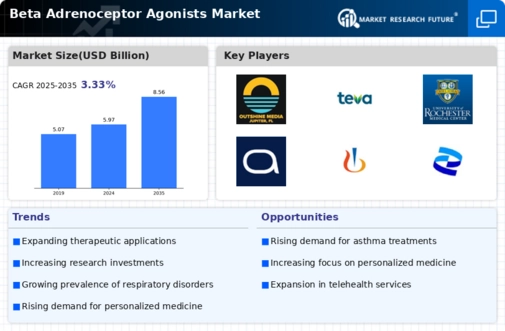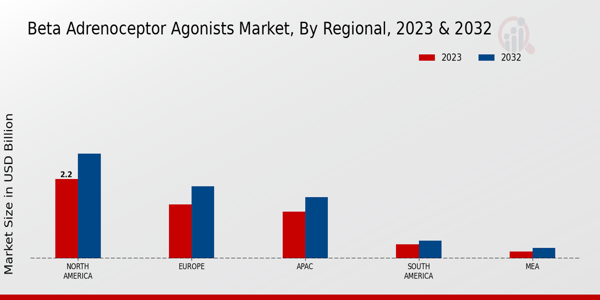Market Trends and Projections
The Global Beta Adrenoceptor Agonists Market Industry is characterized by various trends and projections that indicate its future trajectory. As of 2024, the market is valued at 5.97 USD Billion, with expectations of reaching 8.56 USD Billion by 2035. The compound annual growth rate is projected at 3.33% from 2025 to 2035, reflecting a steady increase in demand for beta agonists. Factors such as the rising prevalence of respiratory disorders, advancements in drug formulations, and an aging population contribute to this growth. These trends suggest a robust market landscape, with opportunities for innovation and expansion in the beta adrenoceptor agonists sector.
Increasing Geriatric Population
The Global Beta Adrenoceptor Agonists Market Industry is significantly impacted by the increasing geriatric population, which is more susceptible to respiratory ailments. As the global demographic shifts towards an aging population, the demand for effective treatment options rises correspondingly. Older adults often experience comorbidities that exacerbate respiratory conditions, necessitating the use of beta agonists for management. This demographic trend is likely to propel the market forward, with a projected compound annual growth rate of 3.33% from 2025 to 2035. The healthcare sector's focus on geriatric care will further enhance the accessibility and utilization of beta adrenoceptor agonists, thereby fostering market growth.
Advancements in Drug Formulations
Innovations in drug formulations significantly influence the Global Beta Adrenoceptor Agonists Market Industry. The introduction of novel delivery systems, such as nebulizers and inhalers, enhances the efficacy and patient compliance of beta agonists. These advancements facilitate targeted delivery, reducing systemic side effects and improving therapeutic outcomes. As the market evolves, pharmaceutical companies invest in research and development to create more effective formulations. This trend is expected to contribute to the market's growth, with projections indicating a rise to 8.56 USD Billion by 2035. Enhanced formulations not only address existing patient needs but also expand the potential user base, thereby driving market dynamics.
Growing Awareness of Preventive Healthcare
The Global Beta Adrenoceptor Agonists Market Industry benefits from the growing awareness of preventive healthcare measures. As individuals increasingly recognize the importance of managing respiratory health proactively, the demand for beta agonists rises. Public health campaigns and educational initiatives play a crucial role in informing patients about the benefits of early intervention and proper medication adherence. This heightened awareness is expected to drive market growth, as more patients seek effective treatments for respiratory conditions. The market's value is anticipated to increase, reflecting a shift towards preventive healthcare strategies that prioritize the management of chronic diseases through the use of beta adrenoceptor agonists.
Rising Prevalence of Respiratory Disorders
The Global Beta Adrenoceptor Agonists Market Industry experiences growth driven by the increasing prevalence of respiratory disorders such as asthma and chronic obstructive pulmonary disease. As of 2024, the market is valued at approximately 5.97 USD Billion, reflecting heightened demand for effective therapeutic options. The World Health Organization indicates that respiratory diseases are among the leading causes of morbidity and mortality globally. This trend necessitates the development and availability of beta agonists, which are pivotal in managing these conditions. Consequently, the market is poised for expansion as healthcare systems prioritize respiratory health, thereby enhancing the accessibility and utilization of beta adrenoceptor agonists.
Regulatory Support for Innovative Therapies
Regulatory bodies worldwide are increasingly supportive of innovative therapies, positively influencing the Global Beta Adrenoceptor Agonists Market Industry. Streamlined approval processes for new formulations and delivery methods encourage pharmaceutical companies to invest in research and development. This regulatory environment fosters innovation, allowing for the introduction of advanced beta agonists that meet evolving patient needs. As a result, the market is likely to experience sustained growth, with a projected increase in value to 8.56 USD Billion by 2035. The proactive stance of regulatory agencies not only enhances the availability of effective treatments but also instills confidence in both manufacturers and patients, thereby driving market dynamics.






















Leave a Comment